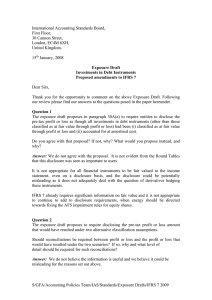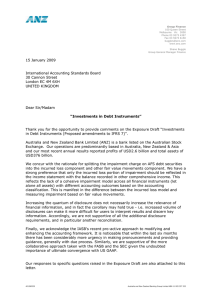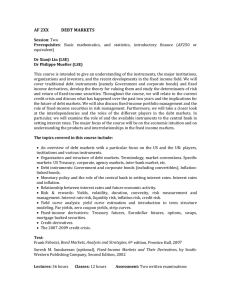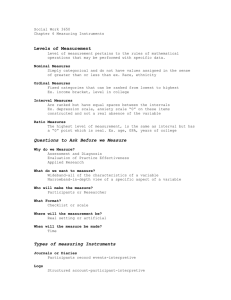Final_Auckland City Submission ED Investments in Debt Instruments.doc
advertisement
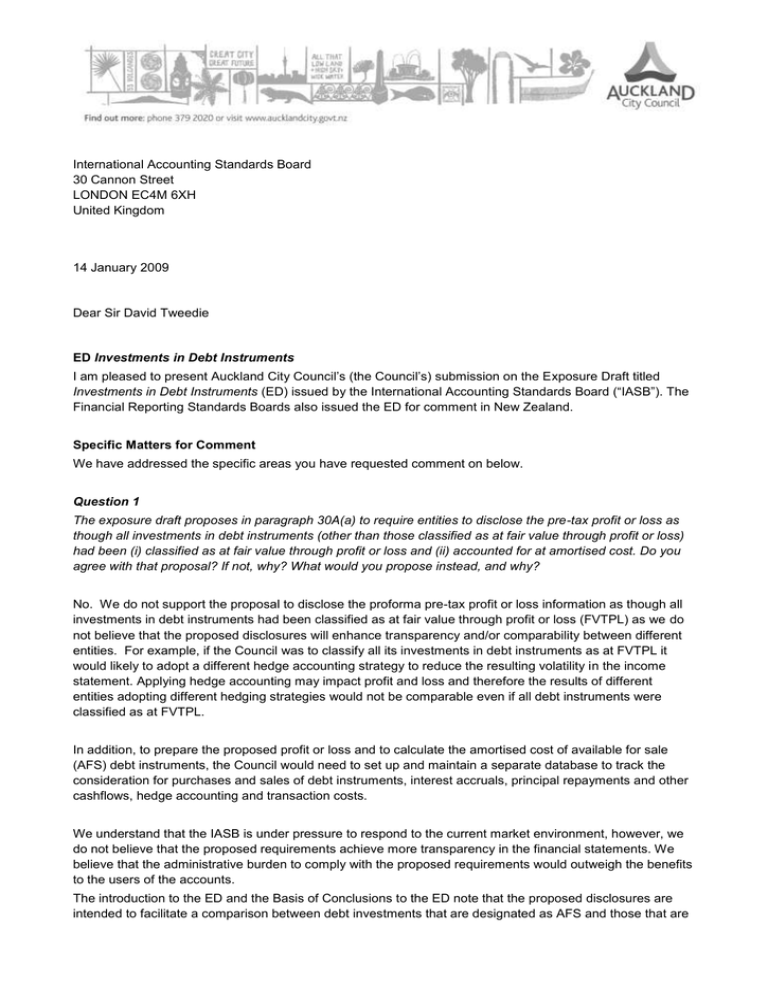
International Accounting Standards Board 30 Cannon Street LONDON EC4M 6XH United Kingdom 14 January 2009 Dear Sir David Tweedie ED Investments in Debt Instruments I am pleased to present Auckland City Council’s (the Council’s) submission on the Exposure Draft titled Investments in Debt Instruments (ED) issued by the International Accounting Standards Board (“IASB”). The Financial Reporting Standards Boards also issued the ED for comment in New Zealand. Specific Matters for Comment We have addressed the specific areas you have requested comment on below. Question 1 The exposure draft proposes in paragraph 30A(a) to require entities to disclose the pre-tax profit or loss as though all investments in debt instruments (other than those classified as at fair value through profit or loss) had been (i) classified as at fair value through profit or loss and (ii) accounted for at amortised cost. Do you agree with that proposal? If not, why? What would you propose instead, and why? No. We do not support the proposal to disclose the proforma pre-tax profit or loss information as though all investments in debt instruments had been classified as at fair value through profit or loss (FVTPL) as we do not believe that the proposed disclosures will enhance transparency and/or comparability between different entities. For example, if the Council was to classify all its investments in debt instruments as at FVTPL it would likely to adopt a different hedge accounting strategy to reduce the resulting volatility in the income statement. Applying hedge accounting may impact profit and loss and therefore the results of different entities adopting different hedging strategies would not be comparable even if all debt instruments were classified as at FVTPL. In addition, to prepare the proposed profit or loss and to calculate the amortised cost of available for sale (AFS) debt instruments, the Council would need to set up and maintain a separate database to track the consideration for purchases and sales of debt instruments, interest accruals, principal repayments and other cashflows, hedge accounting and transaction costs. We understand that the IASB is under pressure to respond to the current market environment, however, we do not believe that the proposed requirements achieve more transparency in the financial statements. We believe that the administrative burden to comply with the proposed requirements would outweigh the benefits to the users of the accounts. The introduction to the ED and the Basis of Conclusions to the ED note that the proposed disclosures are intended to facilitate a comparison between debt investments that are designated as AFS and those that are designated as at amortised cost. We do not believe that this comparability will be achieved by the proposed requirements. Further, we do not believe that disclosing such comparison would add value to the information included in the accounts; rather, it could have the opposite effect and make the financial statements less readable by effectively disclosing two different loss amounts for the same instrument. It would also have the effect of undermining the confidence that a non-expert user of financial statements has in the primary financial statements. Further, the term “investments in debt instruments” is not defined in the ED or in IFRS. It is not clear therefore, what is the scope of the ED and what type of financial instruments are intended to be captured. For example, did the ED intend to capture all financial assets, except for those at FVTPL and equity securities? IFRS 7 already requires extensive disclosures in relation to credit risk for all financial assets and therefore we believe that the proposed disclosures are unnecessarily extensive and do not achieve the intended transparency for AFS debt instruments. Question 2 The exposure draft proposes to require disclosing the pre-tax profit or loss amount that would have resulted under two alternative classification assumptions. Should reconciliations be required between profit or loss and the profit or loss that would have resulted under the two scenarios? If so, why and what level of detail should be required for such reconciliations? No. Consistent with our response to question 1, we do not support the proposed disclosure requirements as we do not believe that the proposed requirements achieve more transparency in the financial statements. Question 3 The exposure draft proposes in paragraph 30A(b) to require entities to disclose for all investments in debt instruments (other than those classified as at fair value through profit or loss) a summary of the different measurement bases of these instruments that sets out (i) the measurement as in the statement of financial position, (ii) fair value and (iii) amortised cost. Do you agree with that proposal? If not, why? What would you propose instead, and why? No. As noted above, we do not support the proposed disclosure requirements as they do not achieve the objective of transparency in the financial statements. IFRS 7 already requires the disclosure of fair value by class of financial asset. Therefore the only additional information would be to provide the amortised cost for AFS debt instruments. We are concerned that rather than achieving transparency in the financial statements, the additional requirements will result in “information overload” so that the information disclosed in the financial statements will become harder to understand by the users of the accounts. Question 4 The exposure draft proposes a scope that excludes investments in debt instruments classified as at fair value through profit or loss. Do you agree with that proposal? If not, would you propose including investments in debt instruments designated as at fair value through profit or loss or those classified as held for trading or both, and if so, why? Yes. Consistent with the Board’s concerns set out in BC6, we agree that investments in debt instruments classified as at fair value through profit or loss should not be required by any disclosures as entities are not required to maintain amortised cost information for these instruments. Page 2 Question 5 Do you agree with the proposed effective date? If not, why? What would you propose instead, and why? No. We also note that the proposed effective date is retrospective for annual periods ending on or after 15 December 2008. Given the complexity involved in gathering this information, should the Board move forward with these proposed disclosures, at the very least the effective date should be changed to annual periods beginning on or after 1 January 2009 to allow a reasonable period of time for implementation which is consistent with the proposed effective date of the Exposure Draft: Improving Disclosures about Financial Instruments: Proposed amendments to IFRS 7. Question 6 Are the transition requirements appropriate? If not, why? What would you propose instead, and why? Had we been supportive of the proposals, we would agree that given the timeframe with which entities have to prepare the disclosures comparative information should not be required in the first year of application. Concluding comments Please contact the undersigned should you wish to discuss the content of this letter. Yours faithfully Ravi Ganeshalingam Corporate Finance Manager Page 3

